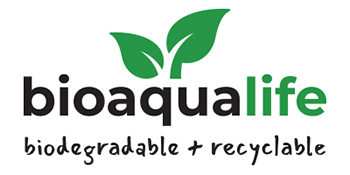We understand:
- Most consumers dispose of their waste (including single-use plastics) in landfills.
- While we would prefer, there are many issues with recycling of plastics. Primarily due to cost and lack of infrastructure
We offer a logical solution: Biodegradable plastic products!
- This is for consumers who require the benefits of traditional plastic but are mindful of their impact on the environment.
- Can be either reusable or recyclable.
- Biodegrades, unlike conventional plastics. Biodegradation of plastic is achieved by enabling microorganisms to metabolize (i.e. break down) the molecular structure of the plastic, which produces an organic matter which is a natural plant fertilizer and a biogas
- Will not fragment into microplastics during biodegradation.
Theoretically, any material made up of organic compounds is biodegradable. No matter how long it takes, the carbon-based material will inevitably be oxidized into carbon dioxide and water via microbial respiration. Biodegradable materials are materials that can be broken down naturally by microorganisms such as bacteria, fungi, and algae. The degradation of these materials occurs in the presence of oxygen to produce water, carbon dioxide, minerals, and new biomass over time. However, it is also possible for these materials to be biodegraded by anaerobic bacteria (in the absence of oxygen).
Compostable materials, like biodegradable materials, are broken down by microorganisms but with a key difference: The broken-down matter must enhance the nutritious quality of the soil without introducing any toxicity. Also, this entire process must take place within 12 weeks for a material to be considered compostable. Commercially produced compostable products (such as the compostable cutlery, cups and plates used by many restaurants) need to be sent to an industrial composting facility in order to biodegrade, where adequate conditions (such as temperature, humidity, etc.) are maintained. They will not break down in a home compost pile or a landfill.
Degradation is a decomposition process that terminates in the fragmentation of plastics under the conditions of heat, sunlight, and moisture, resulting in the weakening of the plastic’s physical structure. So-called « oxo » degradables are in this category. The end product is many microscopic particles that are even more problematic than before degradation as they may find their way into the diet of animal life and influence the food chain. Many experts have suggested that degradable plastics do not solve any problem but instead push the problem into the future, with the production of micro plastics. The European Union has banned these plastics for just this reason. We do not use or support oxo-degradable/fragmentable additives.
Yes, our products are truly biodegradable in a landfill environment – where 91% of all plastic waste will end up. Our proprietary organic additive target microorganisms capable of processing petroleum molecules. It has been tested using ASTM D5511 standards to ensure our plastics are truly biodegrade in a landfill.
We use an organic enzyme to attract naturally occurring anaerobic bacteria in the landfill to digest the enzymes and break down the large plastic polymer molecules into smaller organic molecules that the bacteria then recognize as food. They then digest these smaller molecules and continue the process until the plastic is fully biodegraded.
Yes. With so many manufacturers and retailers offering ‘green’ products, it has become confusing to distinguish between what is a genuine biodegradable product, what is a compostable product, what is a degradable product, and what are unsubstantiated claims. We have ASTM and BMP tests, which are recognized internationally as being the benchmark of verifications. The ASTM D5511 is a test performed by an independent laboratory that measures the carbon released from the plastic as a biogas to verify claims of biodegradability in anaerobic conditions, intending to replicate conditions found in a typical landfill.
No. There is no toxic residue when the biodegradable plastic decomposes. Plastic such as polyethylene break down to CH4, C02 and organic matter.
No. It has no shelf life or expiry dates and will only biodegrade when disposed of in a landfill.
No. biodegradable plastics will biodegrade when buried in soil and require no light or oxygen.
Yes. We have had our product tested and approved by a leading recycling company.
